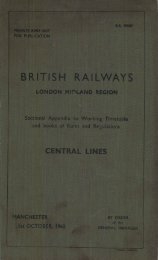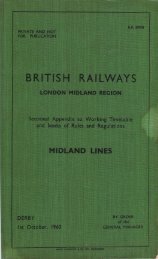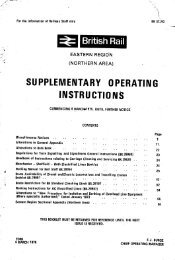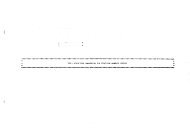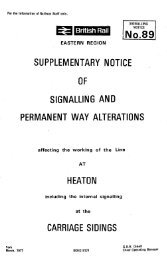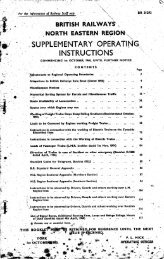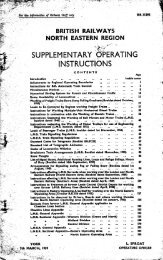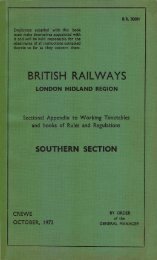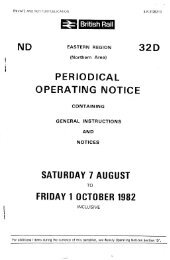general instructions. - Limit Of Shunt
general instructions. - Limit Of Shunt
general instructions. - Limit Of Shunt
You also want an ePaper? Increase the reach of your titles
YUMPU automatically turns print PDFs into web optimized ePapers that Google loves.
204 Special Instructions applicable at Particular Places.—Continued.<br />
STAITH ES VIADUCT,<br />
No train must be permitted to travel along the viaduct when the windgauge<br />
affixed to the viaduct registers a force of 28 lbs. to the square foot<br />
or more.<br />
The wind-gauge is so connected electrically with a bell in the Staithes<br />
signal box that should the wind pressure amount to 28 lbs. per square foot<br />
the bell will ring continuously so long as that or any higher pressure exists.<br />
In the event of a gale, the ganger or one of the platelayers must proceed<br />
to the station sons to be ready in case the bell rings, to make an inspection<br />
of the Viaduct on the bell ceasing ringing before a train is allowed to pass<br />
on to the Viaduct. Should the Viaduct bell commence ringing, and there<br />
is no permanent way man at the station, the Station Master will be held<br />
responsible for sending for the nearest platelayer to make an examination<br />
of the Viaduct.<br />
Immediately the bell commences to ring, the following <strong>instructions</strong> must<br />
be observed :—<br />
(I) When the bell from the Viaduct rings in the Staithes box, the signalman<br />
there must at once send the Obstruction danger signal to Grinkle, and<br />
this must not be cancelled until the Viaduct is safe for trains to cross, except<br />
as under :—<br />
In the event of a mineral train arriving at Grinkle for Boulby Mines<br />
during the time that the Obstruction danger signal is in force, the Station<br />
Master there should communicate with the Station Master at Staithes. The<br />
latter, after satisfying himself that the protection of the obstruction has<br />
been carried out in accordance with Rule 217, may authorise the signalman<br />
to withdraw the Obstruction danger signal. This will enable the signalman<br />
at Grinkle to obtain the occupation key by giving the prescribed bell signal<br />
and so allow the mineral train to have acce§s to Boulby Mines. The train<br />
must, after working at Boulby, return direct to Grinkle, and upon replacing<br />
the occupation key in the instrument at Grinkle and giving the prescribed<br />
bell signal, Staithes must again give the Obstruction danger signal, and keep<br />
the line blocked until the Viaduct is 'safe for trains to cross.<br />
(2) If permission has not been given for a train to leave Hinderwell, the<br />
signalman at Staithes must send the Blocking back inside home signal to<br />
Hinderwell, and the latter station may then offer the Is fine clear signal for<br />
any train which, if it is advisable it should run to Staithes, must be accepted<br />
under the Section clear to Home Signal only signal, and the driver informed<br />
of the circumstances.<br />
(3) Should a train have been accepted by the Staithes signalman from<br />
either direction, when the bell' commences to ring, the Obstruction danger<br />
signal must at once be sent, all fixed signals placed at danger, and prompt<br />
measures taken to stop the train. If such train has entered the section from<br />
Grinkle, it must be detained at the outer home signal until the viaduct is<br />
safe, or arrangements are made for working it back to Grinkle. If a train<br />
has entered the section from Hinderwell it may be brought to the platform<br />
after having come to a stand at the home signal, and the driver informed<br />
of the circumstances. If it is desirable that a second train should reach<br />
Staithes from the Hinderwell direction, it must be dealt with in accordance<br />
with paragraph 2.




